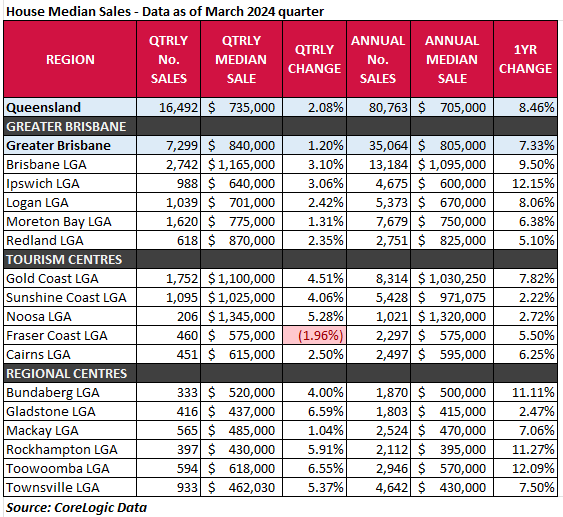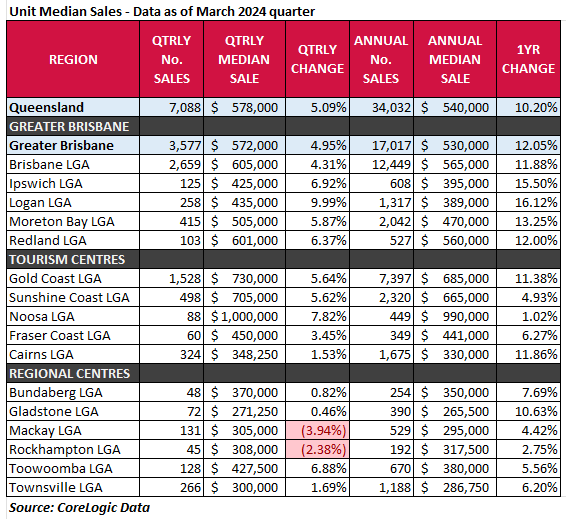Queensland property continues to rise and shine in 2024
Queensland property continues to rise and shine in 2024
With Queensland property prices continuing to climb over the March 2024 Quarter, the Real Estate Institute of Queensland (REIQ) is encouraging aspiring homeowners to think laterally to get onto the property ladder.
Across Queensland, the median price growth of units outpaced that of houses over the quarter, as well as over the year. Units grew 5.09% to $578K and houses rose 2.07% to $735K over the March quarter. Annually, units lifted 10.2% and houses are up 8.46%.
In the capital city, Brisbane houses grew 3.1% to a $1.16m median sale price over the quarter, whereas units rose 4.31% to $605K.
Million-dollar-median markets in the March quarter included Brisbane ($1.16m), Gold Coast ($1.1m), Sunshine Coast ($1.02m), and Noosa ($1.34m) for freestanding houses, and Noosa units ($1m) also nudged up to a million-dollar median.
More palatable figures were found by expanding the net wider outside of the capital city, to the likes of Ipswich ($640K), Logan ($701K) and Toowoomba ($618K) which also boasted impressive growth for both houses and units.
REIQ CEO Antonia Mercorella said sustained growth across the Sunshine State property was being underpinned by a shortage of supply and continued competitive conditions.
“The 2024 Queensland property sales market has set off in a northerly direction, showing positive signs of growth and impressive sales results over the quarter,” she said.
“Relatively affordable price brackets are a magnet for owner occupiers and investors alike, and this broad popularity makes ‘bagging a bargain’ an unlikely scenario.
“Apartments have again forged ahead strongly, notably in the Greater Brisbane areas and relocation hotspots of the Gold and Sunshine Coasts, offering greater affordability, good locations and low-maintenance lifestyle compared to free-standing houses.
“The highest growth for apartments for the quarter was Logan (9.99%) and similarly, Toowoomba apartments stood out in the regions (6.88%) - both markets still sitting comfortably under the half-a-million sweet spot.
“In the housing market, the star performer over the quarter was Gladstone (6.59%), followed by Toowoomba (6.55%), Rockhampton (5.91%) and Townsville (5.27%) demonstrating the continued renaissance of the regions.”
Ms Mercorella said those looking to break into the market as prices continue to creep up, may consider ‘rentvesting’ – buying and renting out a property in a more affordable location, while renting elsewhere to cater to their work and lifestyle.
“Queensland has the lowest proportion of first home buyers in the country and first home buyers make up less than one in five loans in the state,” she said.
“We know it can be disheartening to have to defer the Aussie dream of home ownership while prices continue to climb, but it pays to investigate any grants and concessions available for a leg up, or perhaps consider a sidestep to get onto the property ladder.
“The new $700,000 threshold for stamp duty concessions for first home buyers in Queensland will help boost confidence and allow first home buyers to reach their home ownership goals faster.
“Some astute buyers are getting their foot in the door by adopting a rentvesting strategy to buy for investment purposes and rent for lifestyle purposes.
“For example, a buyer from Brisbane may choose to purchase an investment property four hours away in Bundaberg where the median sale price is half that of Brisbane’s, the vacancy rate is 0.9%, and the median rent is around $500 – with rental income offsetting their mortgage repayments while they continue to rent themselves closer to home.
“In the latest ABS lending indicator data, we saw first home buyers comprise 3.9 per cent of investor loans in Queensland, which equates to over 1,500 loans – up around 60 percent from pre-COVID volumes, so there’s no doubt rentvesting is becoming more prevalent in the Sunshine State.”
Houses data

House market highlights
The highest volume of house sales across the quarter were Brisbane (2,742), Gold Coast (1,752) and Moreton Bay (1,620).
Million-dollar-median markets in the March quarter included Brisbane ($1.16m), Gold Coast ($1.1m), Sunshine Coast ($1.02m), and Noosa ($1.34m).
The strongest house markets for quarterly growth were in the regional markets of Gladstone (6.59%), Toowoomba (6.55%), Rockhampton (5.91%) and Townsville (5.37%).
Fraser Coast (-0.34%) took a small step back over the quarter but held relatively firm to the annual median of $575,000 which represents a 5.5% increase year-on-year.
Looking at annual growth, the star performers were Ipswich (12.15%), Toowoomba (12.09%), Rockhampton (11.27%) and Bundaberg (11.11%) – all double-digit growth and just above the capital city, Brisbane (9.5%).
The longest annual median days on market were seen in Noosa (48 days), Fraser Coast (42 days), Sunshine Coast (34 days) and Gladstone (29 days). The fastest moving markets were Ipswich (16 days), Logan (18 days), and Townsville, Toowoomba and Cairns (all 19 days).
The average house sales campaign length in Queensland was 24 days, and Brisbane’s was 21 days.
Unit data

Unit market highlights
Over the quarter, the highest unit sales volumes were seen in Brisbane (2,659) and the Gold Coast (1,528) – Queensland’s dominate unit markets. The Sunshine Coast and Moreton Bay trailed behind at 498 and 415 sales respectively.
Noosa units nudged their way up to a $1 million median over the March quarter based on 88 sales – a sign of exclusivity and luxury, compared to the capital’s median of $605K.
Units shone brightly for quarterly growth with standouts including Logan (9.99%), Noosa (7.82%), Ipswich (6.92%), Toowoomba (6.88%), and the Redlands (6.37%).
Showing some quarter-to-quarter volatility, Mackay (-3.94%) and Rockhampton (-2.38%) had minor dips compared to the December quarter but remained stable year on year. Units in Bundaberg (0.82%), Gladstone (0.46%), Cairns (1.53%) and Townville (1.69%) also had small improvements that were consistent with the growth performance compared to the previous quarter.
Annually the growth results were highly impressive, with units soaring 16.12% in Logan, 15.5% in Ipswich, 13.25% in Moreton Bay, 12% in the Redlands and 11.88% in Brisbane. Outside of Greater Brisbane, Cairns (11.86%), Gold Coast (11.38%) and Gladstone (10.63%) weren’t far behind, all experiencing double-digit annual growth in their unit markets.
The longest lengths of time to contract for unit sales over the past 12 months were seen in Noosa (52 days) and Gladstone (51 days). Townsville and Mackay followed at 39 and 35 days respectively. Units continue to “fly off the shelf” with days on market in Logan just 14 days, and Toowoomba, Bundaberg, and Brisbane all 16 days,
The state average for unit sales campaign length fell to 21 days.
Notes to Editors:
- Insights derived by the Real Estate Institute of Queensland based on CoreLogic Data.
- A median sale price is derived by arranging a set of sale prices from lowest to highest and the selecting the middle value within this set (i.e. the 50th percentile, where half of recorded sales were less and half were higher than the median).
- Only suburbs and regions to record sufficient sales numbers (at least 10 sales for the quarter) at the time of reporting are considered statistically significant.
- Days on market is calculated as the median number of days it has taken to sell properties (from first advertised date to contract date) by private treaty during the last 12 months (excludes auction listings and listings where an asking price is not advertised).

